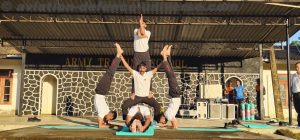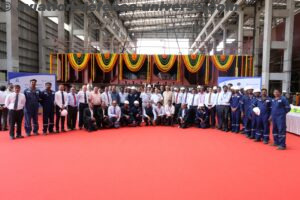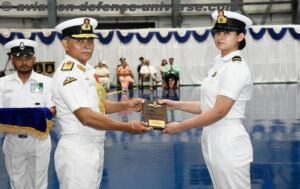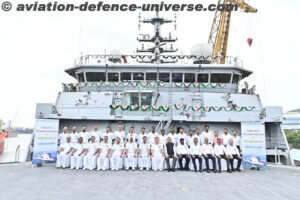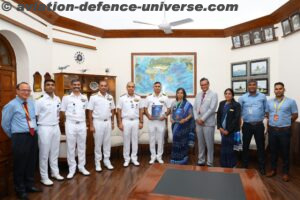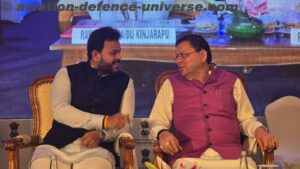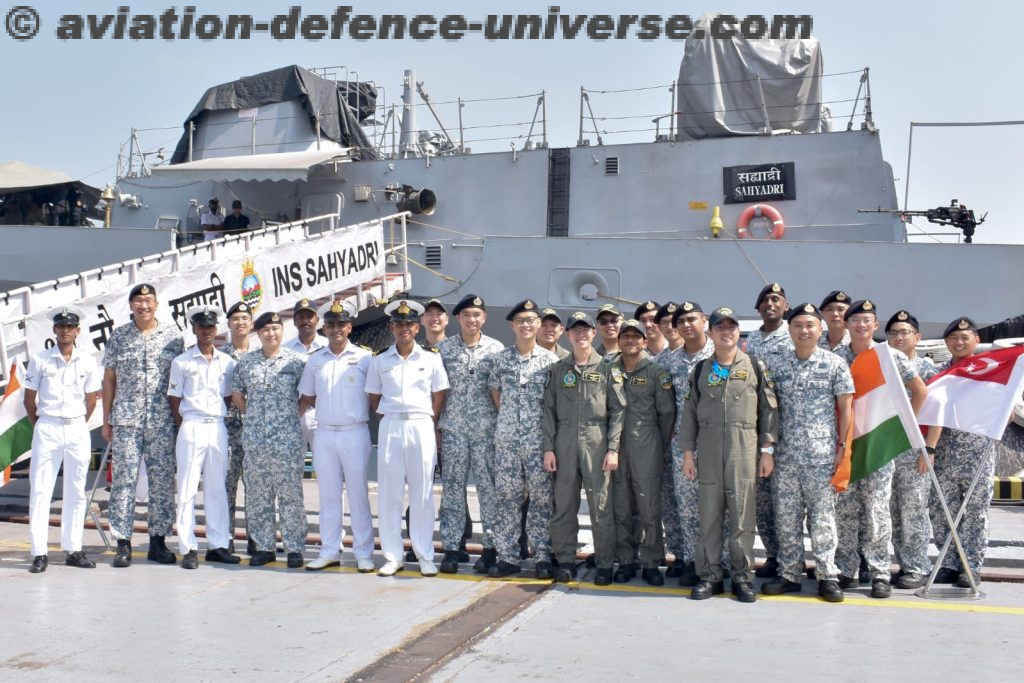 By Ranjit B Rai
By Ranjit B Rai
New Delhi. 14 August 2024. On 15 August 1947, after the partition of assets with Pakistan, the Royal Indian Navy (RIN) consisted of two frigates, four sloops, one transport ship, and three minesweepers. The Navy successfully executed ‘Exercise Peace’ and landed Indian Army troops and equipment to secure Junagadh. Landings were undertaken at Porbandar on 5 October 1947, Jaffarabad on 17 October, and Mangrol on 1 November.
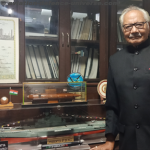 From humble beginnings, the Indian Navy has 136 ships, two aircraft carriers, a nuclear SSBN and 240 aerial assets and has a big 39 warship order book of 1 Type 15B destroyer, 4 Type 17A frigates and 1 Type 75 submarine at Mazagon Docks and Shipbuilders (MDSL) at Mumbai. The Goa Shipyard Ltd (GSL) has 2 Type 1136.5 Krivacks under construction with Russian Collaboration and two similar Krivacks at Yantar Shipyard in Russia, and OPVs and the Cochin Shipyard Ltd (CSL) has 8 Shallow Water ASW Craft under construction. The Larsen &Toubro Ltd (L&T) has 2 Large Multi-Purpose and 3 Training Ships on order, and Garden Reach and Shipbuilders Ltd (GRSE) Kolkata has 3 Type 17A frigates, 2 Survey vessels and 8 Shallow Water ASW Craft under construction. Hindustan Shipyard Ltd (HSL) has 2 Diving Support Vessels on order. The future of the Indian Navy on India’s 77th Independence Day looks promising, and some aspects of its exciting journey need recall.
From humble beginnings, the Indian Navy has 136 ships, two aircraft carriers, a nuclear SSBN and 240 aerial assets and has a big 39 warship order book of 1 Type 15B destroyer, 4 Type 17A frigates and 1 Type 75 submarine at Mazagon Docks and Shipbuilders (MDSL) at Mumbai. The Goa Shipyard Ltd (GSL) has 2 Type 1136.5 Krivacks under construction with Russian Collaboration and two similar Krivacks at Yantar Shipyard in Russia, and OPVs and the Cochin Shipyard Ltd (CSL) has 8 Shallow Water ASW Craft under construction. The Larsen &Toubro Ltd (L&T) has 2 Large Multi-Purpose and 3 Training Ships on order, and Garden Reach and Shipbuilders Ltd (GRSE) Kolkata has 3 Type 17A frigates, 2 Survey vessels and 8 Shallow Water ASW Craft under construction. Hindustan Shipyard Ltd (HSL) has 2 Diving Support Vessels on order. The future of the Indian Navy on India’s 77th Independence Day looks promising, and some aspects of its exciting journey need recall.
THE NAVY’S JOURNEY FROM 1947 IS ONE OF INNOVATION SELF RELIANCE AND ASPIRATIONS
In 1947, the Royal Indian Navy (RIN) was the senior service akin to the Royal Navy in Britain for a while till the Army took over, with C-in-Cs Vice Admiral Sir William Parry till 1951 and Admiral Sir Mark Pizey till 1st April 1955 when India became a Republic. The designation was changed to the Chief of Naval Staff (CNS). Vice Admiral Sir Stephen Carlill was CNS till 24th April 1955, when Vice Admiral Ramdas Katari took over as the first Indian CNS. The Navy sent some 2000 officers and sailors to the UK between 1954 and 1962 to bring back the 28,500-ton aircraft carrier, INS Vikrant (1961), with Seahawk fighters and French Anti-Submarine Warfare (ASW) Alizes and eight new frigates (2 Talwar, 3 Brahmaputra and 3 Khukri class. The Royal Naval’s best practices guided the Indian Navy in its formative years, and the crews that spent months in British shipyards learnt how to build and repair ships.
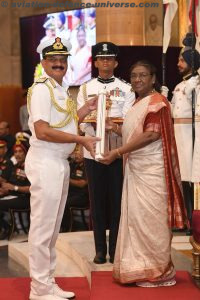
The Navy’s Defence budget share has waxed and waned from mere 12% to 15% until recently, surrendering a significant share to the manpower-intensive Army and the Indian Air Force, a big importer of expensive planes. Yet the Navy grew and carefully used its resources with aspirations and innovations to build ships and submarines, including marine systems in India. The Navy selected the best equipment and platforms from abroad and in India within the budget. This is the Navy’s hallmark, now called ‘Atmanibharta’.
Despite new fighting ships, the Navy was not allowed to participate in the 1965 war with Pakistan. The Cabinet was cautioned by the Intelligence that Pakistan’s submarine, PNS Ghazi (IN had no submarines), was lurking off Bombay. PM Lal Bahadur Shastri took a cautionary approach when the Army was surprised by Pakistan, and only the IAF was called in. The Navy had to wait till 1971 to show its war-fighting capability with the P-15 missiles on Osa Class boats to bomb Karachi, as CNS Admiral SM Nanda, the architect of the war, put it. The Navy cut its teeth in that war in the West, and the East with INS Vikrant and Mukti Bahini which gave birth to Bangladesh.
The Navy brass always wanted to build ships in India. The Navy set up a Design Bureau in a hired building in Greater Kailash in New Delhi and the Weapons Electronics Engineering Systems Establishment (WEESE) with technical naval expertise. These world-class entities have grown as support arms for innovation, designing ships and submarines, modifying ships in refits, and providing the Navy with cutting-edge technology and cyber and Artificial Intelligence (AI). In the 1971 war, the Navy lost INS Khukri to a submarine attack by PNS Hangor (a French Daphne). This goaded the Navy, led by Cdr Arogyaswami Paulraj, to design sonars to detect submarines. The sonar called APSOH is fitted on all front-line ships and saw exports. Commodore Paulraj migrated to Stanford in the USA, designed the Mi-MO technology used in mobile phones, and was awarded the Padma Bhushan in 2010.
The Navy is called the silent service, as ships serve at sea away from glaring eyes, and its submarines run deep and silently; so many look at the Navy with the saying, ‘a girl in every port’, which is far from the truth. Yet in 1972, Mrs Indira Gandhi, while commissioning the Navy’s imposing six-floored seaside Officer’s mess in Colaba, addressed the sea of white uniforms and, in a jovial mood, said, “Your white naval uniform looks attractive to almost every young girl and did to me too”, to a resounding applause. The Mess was innovatively built to four-star hotel standards within the MES allowances.
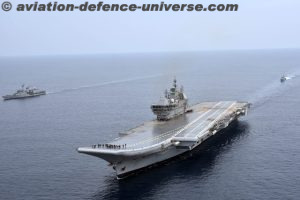 By 1972, the Navy built and commissioned INS Nilgiri, a big 3000-ton Leander frigate with twin 4.5-inch guns, Seacat AA missiles and Diadon French sonar at MDSL with 40 % Indian content, especially the boilers, steam turbines by BHEL, and electrical switchboards and domestic appliances. The Leander design was elongated, modified, and made more current as the powerful 17A Shivalik class and the Navy became a Builder’s Navy. Indian yards have built over 82 ships and submarines, including a 40,000-ton aircraft carrier, INS Vikrant, and shore support facilities. The Navy has taken full advantage of India’s IT and services sector boom, which is too large to list.
By 1972, the Navy built and commissioned INS Nilgiri, a big 3000-ton Leander frigate with twin 4.5-inch guns, Seacat AA missiles and Diadon French sonar at MDSL with 40 % Indian content, especially the boilers, steam turbines by BHEL, and electrical switchboards and domestic appliances. The Leander design was elongated, modified, and made more current as the powerful 17A Shivalik class and the Navy became a Builder’s Navy. Indian yards have built over 82 ships and submarines, including a 40,000-ton aircraft carrier, INS Vikrant, and shore support facilities. The Navy has taken full advantage of India’s IT and services sector boom, which is too large to list.
PM Modi coined Mission SAGAR-(security and growth for all in the region), and the Navy has contributed much to the Indian Ocean Region (IOR) as a ‘net security provider’. The Navy’s Information Fusion Centre (IFC-IOR) in Gurgaon maintains a 24×7 plot of the Indian Ocean for friendly nations with fourteen attached foreign officers to share the Action Information response (AIS) from ships, intelligence and other inputs. An oceanic plot is an inescapable tool for operational planning and Search and Rescue Operations (SAR), and geographic sections can be shared via the Internet in real-time. During the COVID-19 pandemic, the Navy joined Mission ‘Vande Bharat’ and deployed six ships to Maldives, Mauritius, Seychelles, Madagascar, and Comoros in Op Samudra Sethu.
The Navy has grown and inducted state-of-the-art warships from Indian Shipyards and fitted them with radars like phased array M/F Star (Multi-Function) from Israel, Indira from Spain, Scanter and Revathi from DRDO/BEL and some weapon systems like torpedoes and 630mm guns from Indian Public Sector Units (PSUs), the DRDO, and industry, and only imported a few unavailable systems. The DRDO’s Midhani Dhatu Nigam and the Navy ensured the full range of DMR 249A low carbon high strength (HSLA) steel plates for ships and submarines are manufactured by Indian Steel Companies with competition. This was a big repeat big breakthrough as marine steel must withstand harsh seas and is a large part of the cost of a warship. There are no more vagaries of import delays, and warship construction timelines have shrunk. Larsen and Toubro Ltd (L&T), MDSL and GRSE have delivered ships ahead of schedule.
It is creditable that the command-and-control systems and sonars called the ‘brains a warship’ for all front-line ships INS Vikrant are designed by WEESE and supplied by Bharat Electronics Ltd (BEL) with DRDO and Industry. The latest onboard equipment, like navigation radars, band-hopping communications, and EW sensors, are locally acquired. On large platforms, the sea and land attack 450 km Brahmos (also exported to the Philippines) and 60 km AA Barak missiles are made in India. Multi-role helicopters with missiles, torpedoes, and sonar are a must in big ships and around 10 (total order is 26) of the world’s latest attack helicopters (Lockheed’s Sea-Hawk MH60R) are working up at INS Garuda in Cochin and progressively replacing the older Sea-Kings, that are being converted to transport and SAR roles by Naval Aircraft Yard (NAY). The Navy’s 12 Boeing P8i long-range maritime reconnaissance planes with Harpoon and Mk58 US Torpedoes based at INS Hansa at Goa and Rajali near Arkonam have creditably scoured the seas to direct ships in exercises and SAR. With the Navy’s Geo-Strategic reach now, the Navy has exercised the world over and is a member of the QUAD and is considered a swing state in the competition between the USA and China for dominance.
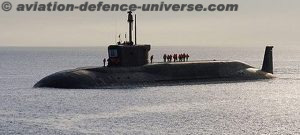
With warfare going digital and into space, the Navy’s cadre of men and women have imbibed digital warfare skills by using USA’s Centrix system with Sea-Riders in Exercises Malabar and has exercised with leading navies of the world and mastered the use of the Navy’s GSAT 7 satellite for the exchange of real-time data between ships, aircraft, and shore Headquarters with links. In his tenure during COVID-19, CNS Admiral Karambir Singh ran the Navy on the Internet like the US Navy and ordered fleet ships to be fuelled and replenished at sea. The Indian Navy employs the Internet for swift decision-making.
On 30 April 2024, CNS Admiral R Hari Kumar turned over the big white chair in South Block to Admiral Dinesh Kumar Tripathi, a very experienced officer who will be expected to take the Navy to greater heights in this maritime century. It is said India’s time has come. Shan na Varuna.
(Cmde Ranjit B Rai is an author and former DNI and DNO who curates a Maritime Museum at C 443 Defence Colony in New Delhi. He was second in Command of INS Nilgiri, commissioned by PM Mrs Indira Gandhi in 1972, referred to as the Navy’s Harbinger Ship with a record commission by its officers and men.)





































